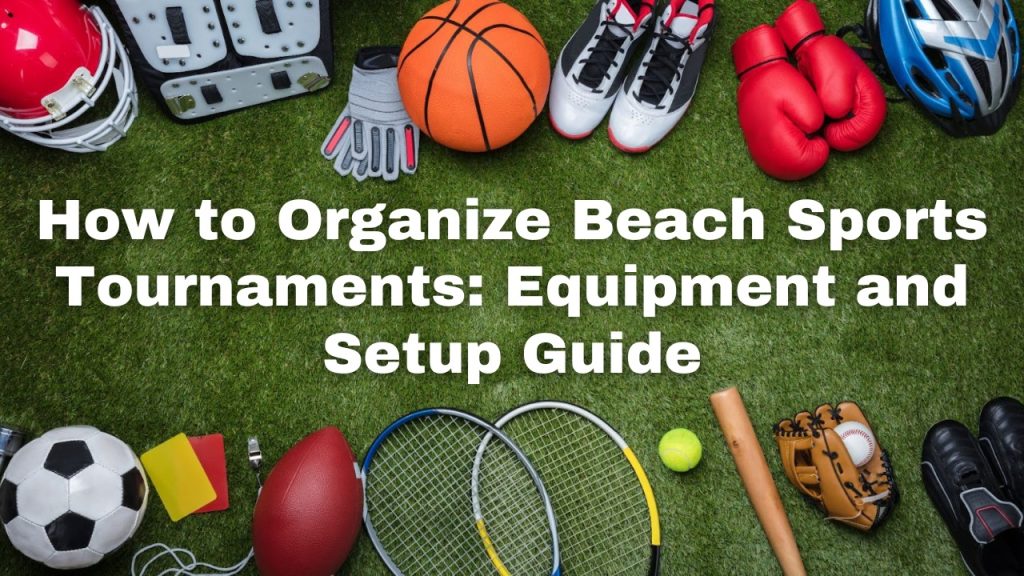
Beach sports tournaments are exciting events that bring together athletes and spectators for a fun and competitive experience. Whether it’s beach volleyball, soccer, or frisbee, organizing a tournament requires proper planning and the right equipment. This guide provides a step-by-step approach to setting up a beach sports tournament, ensuring a smooth and enjoyable event for everyone involved.
1. Choose the Sport and Location
The first step in organizing a beach sports tournament is selecting the type of sport to be played. Popular beach sports include volleyball, soccer, frisbee, and handball. Once the sport is decided, find a suitable beach with enough space for multiple matches, a level playing area, and access to necessary facilities like restrooms and parking.
2. Obtain Necessary Permissions
Before proceeding, check with local authorities to secure permits for hosting the event. Some beaches have regulations on large gatherings, noise levels, and commercial activities. Make sure to comply with these rules to avoid last-minute disruptions.
3. Set Up the Playing Area
Each sport has specific field or court dimensions that must be followed:
- Beach Volleyball: Court size is 8m x 16m with a net height of 2.43m for men and 2.24m for women.
- Beach Soccer: Field size is approximately 35m x 26m with goalposts measuring 5.5m x 2.2m.
- Beach Frisbee: The playing field is 75m x 25m, with end zones of 18m each.
Mark boundaries using ropes, tape, or lightweight cones. Make sure sand is leveled to provide a safe and comfortable playing surface.
4. Arrange Equipment
Having the right equipment is crucial for a successful tournament:
- Nets and Posts: For sports like volleyball and handball, secure durable nets and posts that can withstand wind and impact.
- Balls and Discs: Use sport-specific balls and frisbees designed for sand play to ensure better control and performance.
- Goalposts: Sturdy goalposts are necessary for soccer and handball tournaments.
- Scoreboards and Timers: Digital or manual scoreboards help keep track of game scores and timings efficiently.
- Whistles and Flags: Referees and officials need whistles and flags to manage matches effectively.
5. Set Up Seating and Shade
Since beach tournaments are played under the sun, providing shade and seating is essential. Arrange tents, umbrellas, and portable chairs for players, referees, and spectators. Coolers with water and energy drinks should also be available to keep participants hydrated.
6. Plan for Player Registration and Scheduling
Create an online or offline registration process where teams or individual players can sign up. Organize match schedules in a way that allows adequate rest time between games. Use software or mobile apps to manage fixtures and communicate updates in real-time.
7. Ensure Safety and First Aid
Safety should be a top priority. Have a dedicated first-aid station equipped with bandages, ice packs, and basic medical supplies. It is advisable to have medical professionals or lifeguards on standby in case of emergencies.
8. Organize Referees and Volunteers
Trained referees ensure fair play and smooth game flow. Recruit experienced officials familiar with the rules of the sport. Volunteers can assist in various tasks such as scorekeeping, crowd control, and player assistance.
9. Promote the Event
Attract participants and spectators by promoting the tournament through social media, local newspapers, and community boards. Design engaging posters and digital flyers to create awareness. Consider partnering with local businesses for sponsorships to cover costs and provide prizes for winners.
10. Prepare for Weather Conditions
Beach weather can be unpredictable. Have a backup plan in case of extreme conditions like storms or strong winds. Keep an eye on weather forecasts and inform participants about any potential schedule changes.
11. Conduct a Trial Run
Before the main event, conduct a small practice session or friendly matches to check if all arrangements are in place. This helps in identifying and fixing any logistical issues beforehand.
12. Ensure Smooth Execution on Event Day
On the day of the tournament:
- Arrive early to set up the venue.
- Conduct a quick briefing for referees, volunteers, and participants.
- Keep an announcement system ready to provide updates and instructions.
- Monitor the event and ensure everything runs according to schedule.
13. Award Ceremony and Closing
Recognizing winners and participants makes the event memorable. Organize a small award ceremony with trophies, medals, or certificates. A closing speech thanking players, sponsors, and volunteers adds a professional touch.
14. Post-Event Cleanup
Beaches should be left clean after the event. Arrange for garbage bins and encourage participants to dispose of waste properly. A cleanup team should ensure the venue is restored to its original condition.
Wrapping Up
Organizing a beach sports tournament requires careful planning, the right equipment, and efficient execution. By following these steps, you can host a successful event that is enjoyable for participants and spectators alike. Whether it’s a casual competition or a professional tournament, a well-organized event ensures a thrilling and memorable experience for everyone involved.



